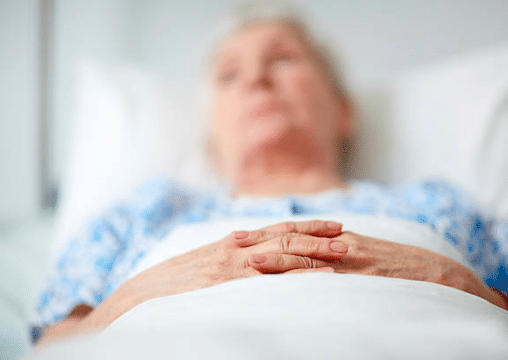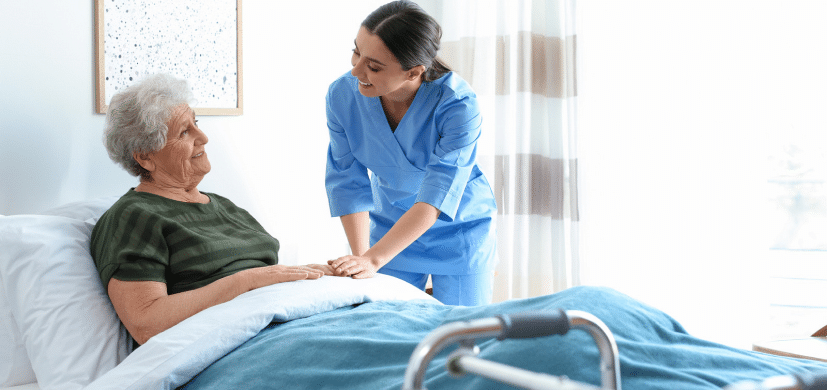Stage 1 Bedsores
Stage 1 bedsores are the mildest form of open wounds that occur as a result of prolonged pressure on the skin. They can develop within hours if someone is immobile, frail or has a chronic illness. In stage 1, the affected area may be discolored or slightly red, and the skin may feel warm or cool, depending on the underlying cause. Treatment for stage 1 bedsores focuses on relieving pressure on the affected area by repositioning the person and keeping the area clean and dry. It is important to seek medical attention if the skin becomes broken or a wound develops.

What is a stage 1 bedsore?
A bedsore is a pressure injury caused by prolonged pressure on the skin. The pressure restricts blood flow, resulting in tissue death. Bedsores most commonly occur when patients remain in the same position for too long.
A bedsore is categorized into four stages based on severity, with stage 1 being the earliest and least severe. Stage 1 bedsores can occur in a matter of hours. A stage 1 bedsore is indicated by an area of discoloration on unbroken skin. Because the damage begins under the surface of the skin, the discoloration could be the least serious part of the bedsore.
Skin pressure leading to bedsores can occur in various forms, including:
- Weight or Force: When the skin is pressed for a long time, usually from the weight of the patient lying or sitting on the affected area, blood flow is restricted and the tissue starts to die.
- Friction: When sheets, clothing, or other material constantly rub a skin area, the tissue is damaged, resulting in bedsores.
- Shear: Shearing occurs when the bone is pulled in one direction and the skin in another. This situation is most common when the bed is inclined, causing the patient to slide downward while the skin remains in place.
- Moisture: Prolonged exposure to moisture from sweat, urine, or fecal matter breaks down tissues in the skin.
Signs of Stage 1 Bedsores
The appearance of a stage 1 bedsore will be red in light-skinned patients and blue or purple in dark-skinned patients. The earliest sign of a stage 1 bedsore is when the skin color fails to return to normal within 30 minutes of removing pressure from the area.
Inflamed skin normally turns white when pressed—this is called blanching. In the case of a bedsore, the skin does not blanch. The area may feel warm to the touch, or it could feel cooler than the surrounding skin. The patient may complain of pain, itching, or a burning sensation.
Where on the body are stage 1 bedsores commonly found?
Stage 1 bedsores most often appear on the bony areas of the body. Bedsores can occur anywhere on the skin, but the following areas are the most susceptible:
For patients in wheelchairs:
- The backs of the arms and legs
- Shoulder blades
- The buttocks, especially around the tailbone
- Areas around the spine
For bedridden patients:
- Heels
- Ankles
- Back of the knees
- The back or sides of the head
- Shoulder blades
- Hips
- Areas around the tailbone
Who’s at risk of developing stage 1 bedsores?
While an individual at any age can develop bedsores, the elderly are most at risk. Elderly patients tend to have thinner skin that’s more vulnerable to damage, and they’re also more likely to have conditions that increase their risk of developing bedsores. These conditions include:
- Immobility: Immobility is the primary cause of bedsores. When a patient is unable to change positions, pressure may be placed on vulnerable areas of the skin for too long.
- Lack of Sensation: Patients with spinal cord injuries, neuropathy, and other numbing conditions cannot feel pain or other warning signs when an area of the skin begins to become damaged.
- Urinary or Fecal Incontinence: These conditions expose the skin to excess moisture.
- Poor Nutrition and Hydration: Lack of essential nutrients and proper hydration adversely impact skin health.
- Poor Circulation: Medical conditions such as diabetes and vascular disease damage the skin and slow healing.
- Smoking: Smoking constricts blood flow to all areas of the body, including the skin.
Treating Stage 1 Bedsores
Any bedsore could be serious. Since bedsores originate beneath the surface of the skin, the discoloration may be only a small part of the problem. For this reason, all bedsores require immediate medical evaluation followed by treatment.
Untreated bedsores don’t go away on their own. In fact, without treatment, bedsores worsen and become more serious—even potentially life-threatening. The most common complications of untreated bedsores include:
- Progression to later stages of bedsores, like stage 3 can be characterized by broken skin and deepening of the wound
- Infections of the skin, muscles, or bone that could become systemic and life-threatening
- Cancer, especially squamous cell carcinoma
Bedsores are easier to treat in the early stages before complications develop. Stage 1 bedsores can heal in a matter of days. If allowed to progress, healing could be delayed by months or even years. If you suspect your loved one has a bedsore, get a medical evaluation as soon as possible.
The doctor can usually diagnose a stage 1 bedsore through visual examination. The doctor will check for other bedsores and may order a blood test or tissue swab to rule out additional issues.
Treatment for stage 1 bedsores should then commence immediately.
Relieving the Pressure
The area will need to remain free of pressure, friction, or shearing to allow adequate blood flow to the region. The doctor may order specialized mattress pads, cushions, or other adaptive equipment to prevent pressure on the affected area. The doctor will also require that the patient’s position be changed frequently.
Wound Care
Stage 1 bedsores don’t always require dressing. The wound can be gently cleaned with soap and water, then thoroughly dried and kept dry. The doctor may order moisture barriers to help keep the area dry, especially in cases where the area is at risk of prolonged exposure to moisture.
In cases where dressings are required, doctors often prescribe transparent films or hydrogels for stage 1 bedsores. These dressings typically need to be changed once every 3-7 days.
The doctor will monitor the wound closely and run additional tests if the wound doesn’t respond to treatment.
Nutritional Support and Hydration
Malnutrition impedes the healing of bedsores. The doctor may evaluate the patient’s diet and fluid intake and prescribe hydration and nutritional support as needed. In case of severe malnutrition, tube-feeding and/or IV fluids may be prescribed.
Complications of Stage 1 Bedsores
With early diagnosis and proper treatment, stage 1 bedsores have an excellent prognosis and can heal in as few as three days. Patients with wound-healing impairments, such as diabetes, may experience slower healing or a progression to the later stages, even with treatment. If the skin is broken, the bedsore becomes a stage 2 bedsore. This stage can be much more painful and requires a greater level of care to prevent infection.
Bacterial infections are the most common complication from bedsores. These are rare in stage 1 bedsores since the skin is unbroken.

Are stage 1 bedsores preventable?
Nursing home patients experience bedsores when staff fails to provide the standard of care required for vulnerable patients. The emergence of a bedsore almost always points to neglect, and elderly patients deserve better.
Bedsores are 100% preventable, and there’s no excuse for nursing homes that allow patients to develop these painful, dangerous wounds. Prevention is more effective and less painful than treatment. Nursing homes can do the following to prevent stage 1 bedsores:
- Turn and reposition bedridden patients at least once every two hours.
- Reposition wheelchair-bound patients at least once every 15 minutes and ensure they are sitting up straight.
- Provide pressure-reducing padding and support to parts of the body most susceptible to pressure injuries.
- Avoid rough or wrinkled sheets or blankets.
- Apply powder to the sheets to reduce friction.
- Keep the skin clean and dry.
- Ensure the patient stays hydrated and receives adequate nutrition.
- Avoid inclining the bed by more than a 30-degree angle to prevent shearing.
- Move patients by lifting rather than sliding.
- Monitor each patient’s diet and fluid intake to ensure the patient receives adequate hydration and nutrition, and supplement as necessary.
- Inspect patients multiple times per day for stage 1 bedsores.
This is not an exhaustive list. Every patient is different and requires an individualized plan to prevent bedsores.
Reporting Nursing Home Neglect or Abuse
Bedsores are almost always caused by neglect. If you suspect a stage 1 bedsore is the result of neglect within a nursing home facility, you have the power to stop it by reporting the abuse to the local police, adult protective services, or the ombudsman in the nursing facility. You should be able to locate the ombudsman for your loved one’s nursing facility in the admissions paperwork or by asking the front desk. If an emergency is occurring, please call 911.
All of these reporting entities are required to investigate every allegation of abuse. Many will follow up with you, especially if the victim is your family member.
Nearly all localities have a hotline where you can reach adult protective services. Adult protective services often include the police in their investigation when criminal abuse is alleged. You can learn more about how to reach adult protective services in your state by visiting the National Center on Elder Abuse’s state directory.
- Last Modified September 12, 2023
- Editorial Guidelines
Dr. Patricia Shelton, MD

Education:
- University of Washington, Doctor of Medicine – MD. June 2008
- University of Washington, Bachelor of Science – BS, Jun 2003
Background:
Neuroscience and Medicine
Career:
- Dr. Shelton primarily writes content for health-related websites, but has also written test prep materials, white papers, published research articles, court documents, and more.
- Dr. Shelton teaches anatomy and physiology at the college level for the National Institutes of Health.
